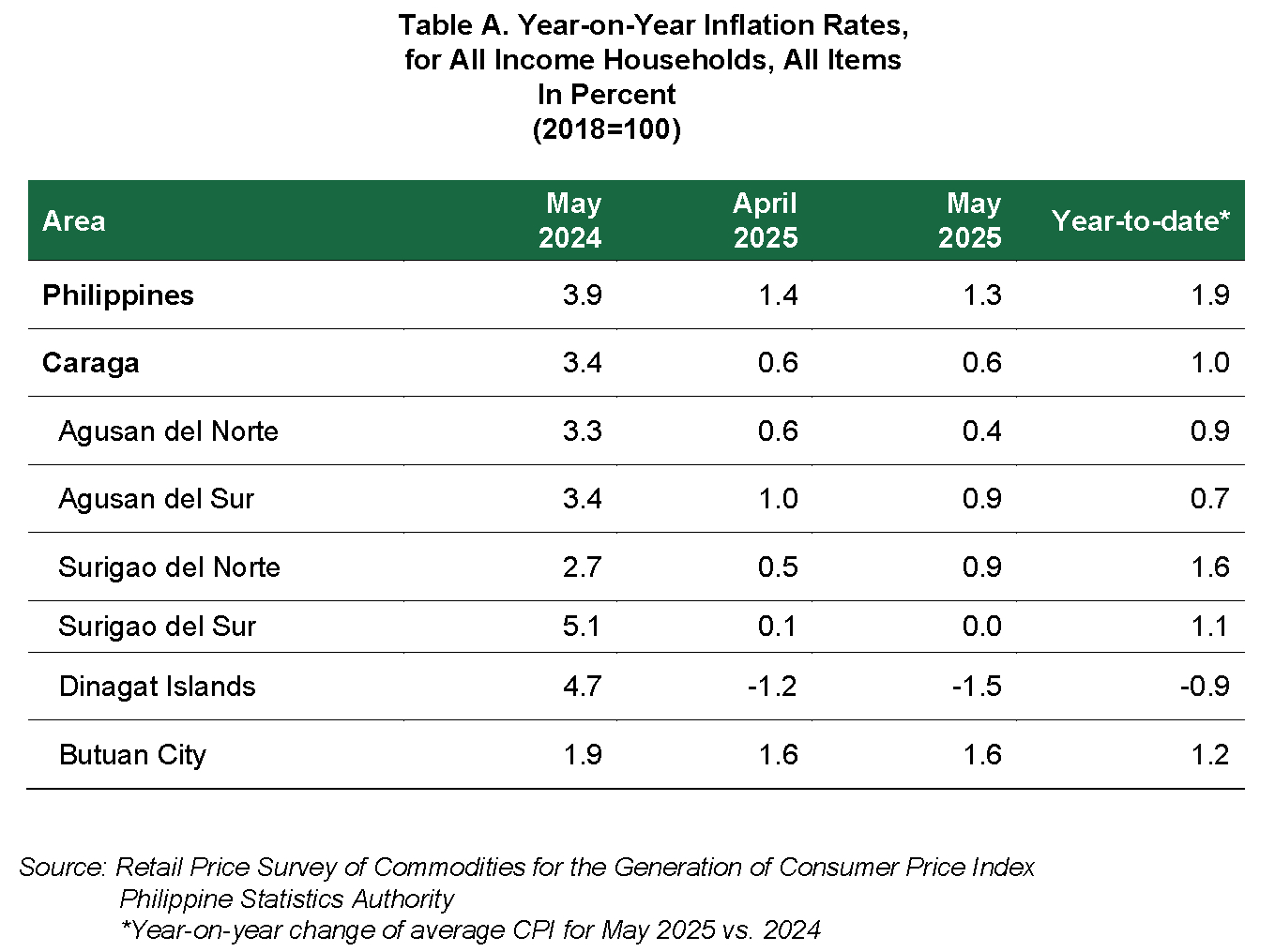
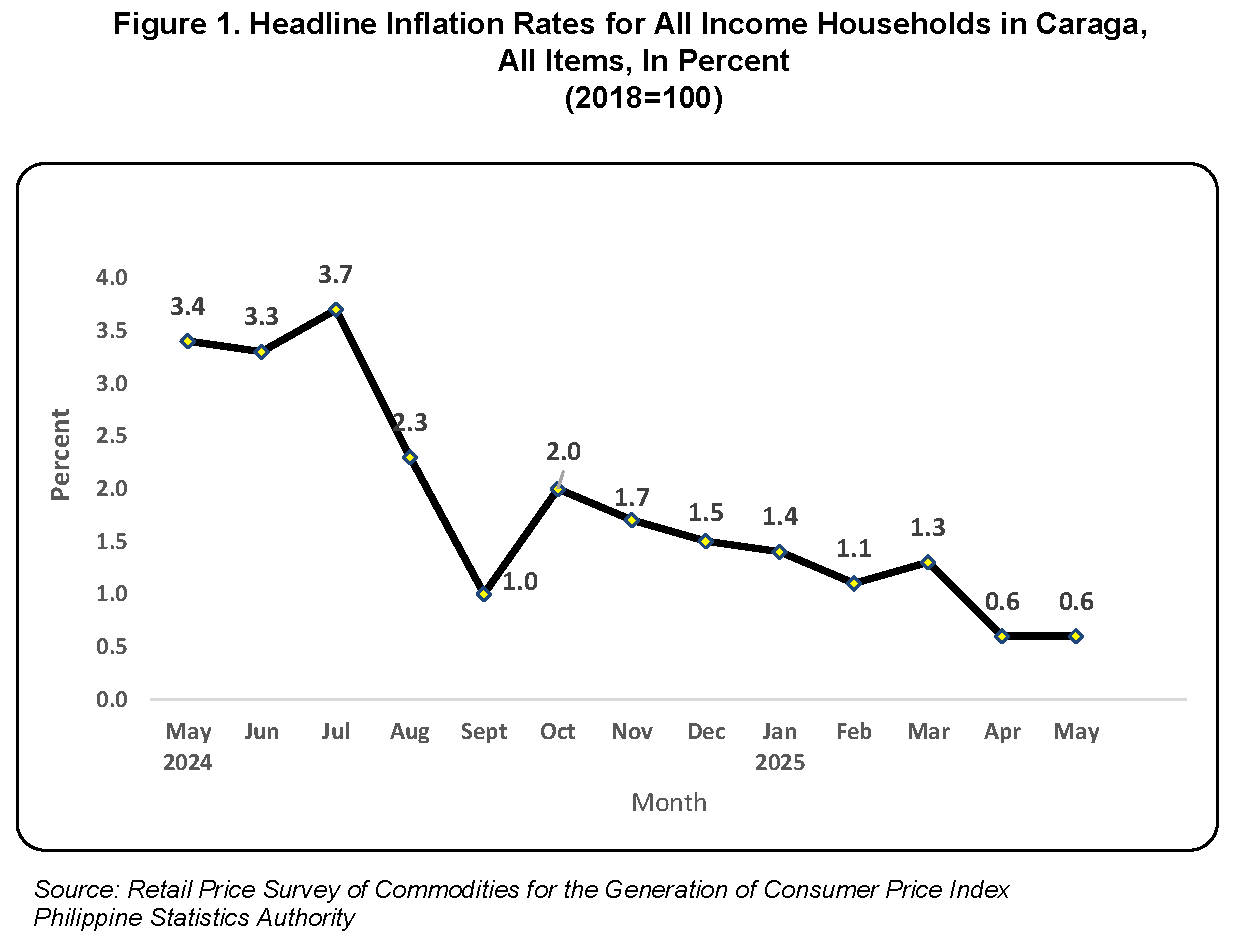
A. Caraga
1. Headline Inflation
Headline Inflation in Caraga is stable at 0.6 Percent in May 2025
The headline inflation rate for all income households in the Caraga region remained at 0.6 percent in May 2025, unchanged from the previous month. This indicates that the average prices of goods and services continued to increase at the same pace as in the previous month. Compared to the same period last year, this month’s rate reflects a 2.8 percentage point decrease. (Refer to Table A, Table B, and Figure 1 for more details.)
Among the 13 commodity groups, Housing, Water, Electricity, Gas and other Fuels emerged as the main contributor to the overall inflation in May 2025. The average price change for this group rose to 3.8 percent, a notable increase from 3.4 percent in April 2025. This group accounted for a substantial 96.7 percent share of the overall inflation rate.
The key contributors to the overall inflation within the Housing, Water, Electricity, Gas and other Fuels group were the electricity, actual rentals paid by tenants and water supply with an inflation rate posted at 8.2 percent, 2.1 percent and 8.6 percent, respectively.
The second commodity group that contributed to this month’s inflation is the Alcoholic Beverages and Tobacco. This group posted a 6.2 percent inflation rate for the month, accounting for approximately 26.1 percent of the overall inflation rate. The increase in the average prices of cigarettes was the main contributor to the inflation rate of this group.
The third commodity group is Restaurants and Accommodation Services, which recorded an inflation rate of 2.2 percent, contributing approximately 17.4 percent to the overall inflation rate. The main contributor to this group’s inflation rate was the restaurants and cafés sub-sector.
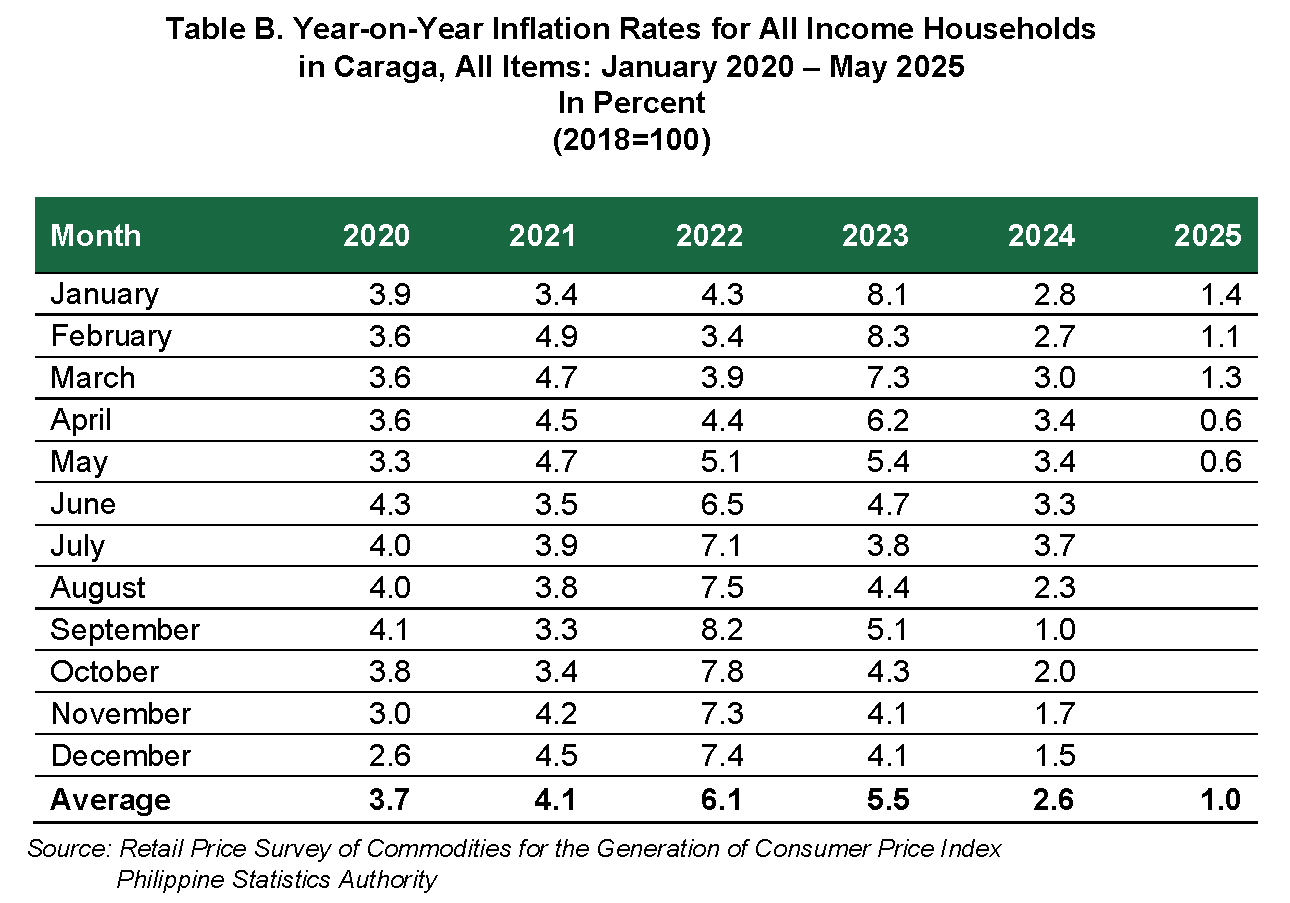
Commodity groups that showed an increased inflation include:
A. Alcoholic Beverages and Tobacco: 6.2 percent from 6.0 percent in the previous month;
B. Housing, Water, Electricity, Gas and other Fuels: 3.8 percent from 3.4 percent; and
C. Furnishings, Household Equipment and Routine Household Maintenance: 1.8 percent from 1.5 percent.
Commodity groups with a decreased inflation include:
A. Information and Communication: 0.8 percent from 1.0 percent last month; and
B. Recreation, Sport and Culture: 3.7 percent from 3.8 percent.
Meanwhile, a slightly faster negative inflation was observed in Transport group with an inflation rate of -2.8 percent this month, compared -2.9 percent in the previous month.
On the other hand, a slightly slower negative inflation was observed in the Food and Non-Alcoholic Beverages group with a -0.9 percent inflation rate in May 2025 from a -0.8 percent inflation rate in April 2025.
Commodity groups that exhibited consistent rates were noted in the following:
A. Clothing and Footwear, at 2.4 percent
B. Health, at 3.5 percent;
C. Education Services, at 1.9 percent;
D. Restaurants and Accommodation Services, at 2.2 percent;
E. Financial Services, at 0.0 percent; and
F. Personal Care, and Miscellaneous Goods and Services, at 2.4 percent.
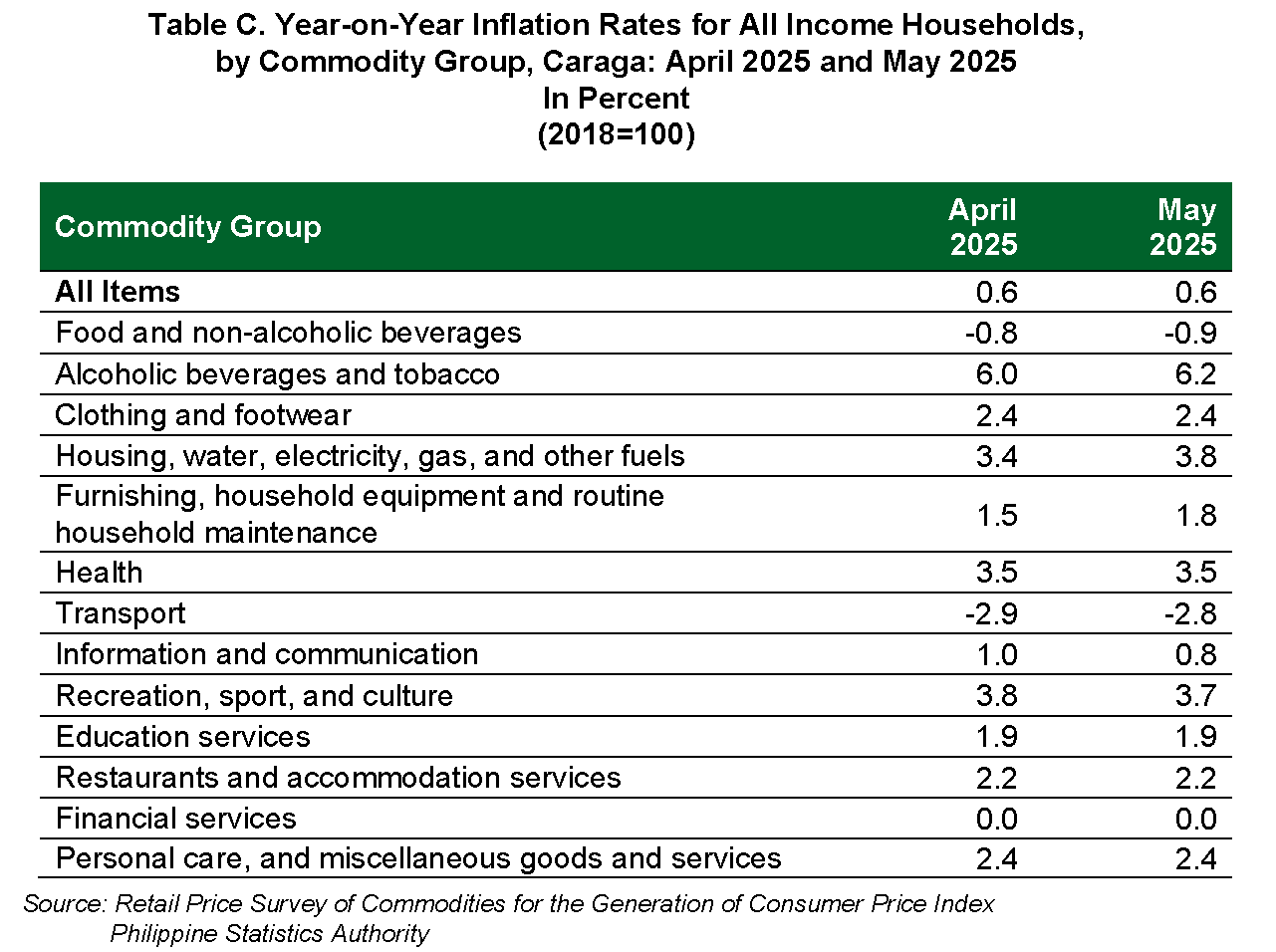
2. Food Inflation
Regional Food Prices Drop: Food Inflation Fell to -1.2 Percent in May 2025
Food inflation for all income households in the Caraga region further declined to -1.2 percent in May 2025, down from -1.0 percent in April 2025. This is a significant drop compared to the 7.5 percent inflation rate recorded in May 2024.
The decline in food inflation in Caraga for May 2025 was primarily attributed to substantial reductions in the inflation rates of key food categories:
A. Cereals and cereal products:
The year-on-year growth rate for this category declined further to -12.5 percent in May 2025, down from -11.4 percent in the previous month. This decrease was primarily driven by the continued drop in rice prices, which fell to -16.0 percent in May from -14.5 percent in April.
B. Vegetables, tubers, plantains, cooking bananas and pulses:
Inflation in this food group declined to 1.3 percent in May 2025, down from 3.7 percent in April 2025. This reduction was primarily driven by a slower year-on-year increase in the prices of other leafy or steam vegetables, such as chayote, and an annual decrease in the average prices of squash (kalabasa).
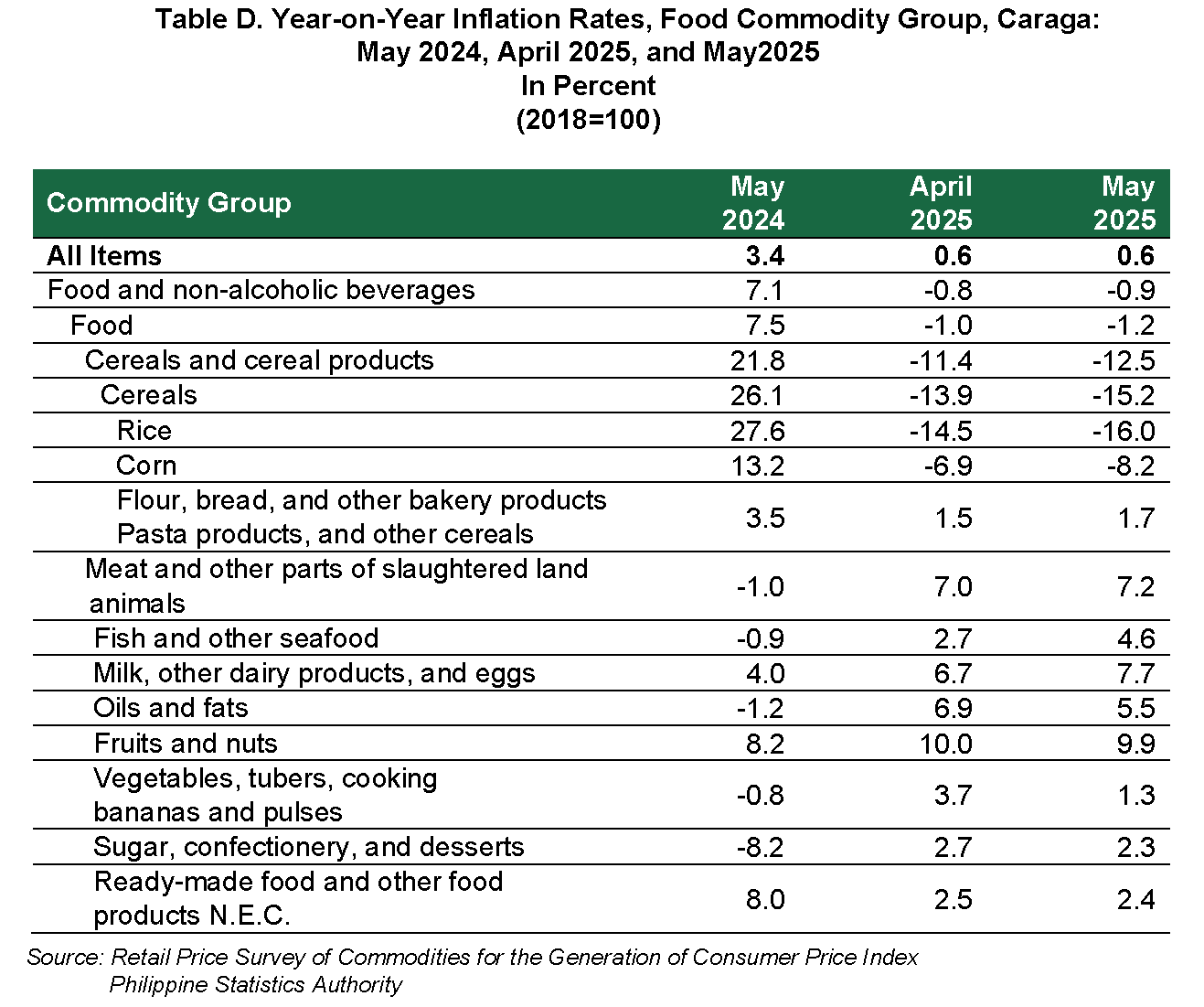
Other food groups with decreased inflation are the following:
A. Corn, at -8.2 percent from -6.9 percent;
B. Oils and fats, 5.5 percent from 6.9 percent;
C. Fruits and nuts, 9.9 percent from 10.0 percent;
D. Sugar, confectionery and desserts, 2.3 percent from 2.7 percent; and
E. Ready-made food and other food products n.e.c., 2.4 percent from 2.5 percent.
On the contrary, increased inflation was recorded during the month in the indices of the following food groups:
A. Flour, Bread and other Bakery Products, Pasta Products and other Cereals, 1.7 percent from 1.5 percent;
B. Meat and other parts of slaughtered land animals, 7.2 percent from 7.0 percent;
C. Fish and other seafood, 4.6 percent from 2.7 percent; and
D. Milk, other dairy products and eggs, 7.7 percent from 6.7 percent.
B. Provinces and Highly Urbanized City (HUC)
In May 2025, inflation trends across the Caraga region varied among its five provinces and one Highly Urbanized City (HUC). Most areas recorded a decline in inflation, including Agusan del Norte, Agusan del Sur, Surigao del Sur and Dinagat Islands. Among the provinces and HUC, Surigao del Norte registered an increased in inflation, rising to 0.9 percent from 0.5 percent in the previous month.
Meanwhile, Butuan City posted the highest inflation rate in the region at 1.6 percent in May 2025 maintaining the same level as in April. In contrast, the Dinagat Islands recorded the lowest inflation rate at -1.5 percent during the same period. (Refer to Table A.)
Note:
CPIs and inflation rates by province and selected city are posted on the PSA website (http://openstat.psa.gov.ph/).
(Sgd.) GUILLERMO M. LIPIO, JR.
(Chief Statistical Specialist)
Officer-In-Charge
PSA RSSO XIII
TECHNICAL NOTES
The Philippine Statistics Authority generates and announces the monthly Consumer Price Index (CPI) based on the nationwide survey of prices for a given basket of goods and services. Two important indicators, the inflation rate and purchasing power of the peso (PPP), are derived from the CPI which are important in monitoring price stability and the value of the country’s currency.
The Consumer Price Index (CPI) is an indicator of the change in the average retail prices of a fixed basket of goods and services commonly purchased by households relative to a base year. It shows how much, on average, the prices of goods and services have increased or decreased from a particular reference period known as the base year.
Inflation Rate refers to the rate of change in the average prices of goods and services typically purchased by consumers. It is interpreted in terms of declining purchasing power of money.
Disinflation refers to a situation where the general level of prices is increasing but at a decreasing rate.
Deflation refers to a situation where the general level of prices is falling, and the rate is below zero percent.
The Purchasing Power of the Peso (PPP) indicates the value of the peso in the period under review as compared to the value of the peso in the base period. It is computed as the reciprocal of the CPI for the period under review multiplied by 100.
Statistical Table refers to the statistical data presenting a reference table for the CPI, and Inflation Rate of each commodity group and food items that are used for attachments.

